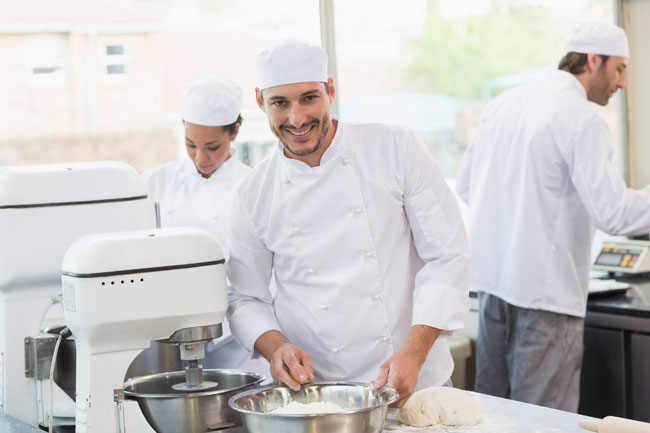Mixing It Up
Countertop Mixers Offer Versality
Main Auction Services Products Education Series

Is your restaurant in the market for a countertop Mixer? How do you know what to buy, and what size does it need to be?
Versality, automatic shut off, automatic recall, built in overloading monitors are just a few of the features of smart countertop mixers. If you are considering the purchase of a countertop mixer; we invite you to consider perspective in that new purchase for your specific location, type of product, and growth plans. Small batch capability means the power to perform a variety of functions, and additional attachments like a wisk, flat mixing paddle and dough hooks will enable new products for your transitional and seasonal meals. If your menu changes, or should we say when your menu changes; make sure you can use the Swiss Army knife of the kitchen to it's full advantage.
In most research, the small but mighty countertop mixer with it's supplemental attachments, your restaurant could now have whipping cream, airy meringues, mashed potatoes, meatballs, mixing cake batters, and kneading bread, pizza and pretzel dough just to name a few. Any of these end results appeal to a restaurant location like yours? Then this mainstay is a must.
Versality equals mainstay for small batch preparation. Whether you are baking, just using a mixer for day to day food prep, additional ideas could include caterers and culinary schools, classes for your community, or prep for schools, universities and institutions. Reducing labor needs, can also offer ergonomic benefits and while most counter top mixers are sized for 5 to 10 quarts, there is availability out there for larger capacity units up to 20 quarts and will still work on a countertop. Amazing!
If you are considering food prep for new revenue streams; larger quantities might require a bigger bench mixer operating on a table or cart with heights of 24 to 27 inches or even a ghi capacity floor mixer. Blurred lines between countertop and bench mixers with name specifics could cause confusion but in the end; kitchen real estate decides do you need a countertop or bench option.
It is standard that countertop mixers are planetary mixers in which the agitator turns on a shaft and revolves around a stationary bowl. Employees can swap out different agitator tools and attach them to the shaft. Spiral shaped agitators that remain stationary while the bowl revolves around it are also ideal for preparing large amounts of dough. Perhaps one restaurant could have multiple types and sizes all in one location for easier usage.
In contrast, a spiral mixer has a spiral-shaped agitator that remains stationary while the bowl revolves around it. Spiral mixers are ideal for operators preparing large amounts of dough who don’t need the versatility of a planetary mixer. While a few spiral mixers might fit on a countertop, most are larger bench or floor models.
So What Should You Purchase For Your Location? Let's consider so additional factors before you purchase:
If you’re in the market for a countertop planetary mixer, start by determining the appropriate size based on your desired output. Don't make the most common mistake is purchasing a mixer that’s too small for the task, your decision. Just because the ingredients fit in the bowl doesn’t mean the mixer can handle that amount. Overloading your mixer could result in a poorly mixed product, or worse, kill your mixer’s motor. You also risk splashes from wet items (picture making salsa in an overloaded mixer). Choosing too small of a mixer is inefficient, and may mean making too many extra batches. Truth be told; if capacity is close, you should always choose the next size up.
Bigger may not always better. If you’re making a small batch, the contents could get lost in a large bowl and not mix well. This could be especially problematic for whipped items, as ingredients won’t reach enough of the whisk’s tines to be mixed efficiently. Bottom line: Find the mixer that’s just the right size.
If you plan on making dough, rely on mathematics to find the appropriate size. A dough’s absorption ratio is the water weight divided by the flour weight, multiplied by 100 to get a percentage. (Water weighs 1 pound per 16 fluid ounces, 81/3 pounds per gallon.) A high AR, like 60%, is a wet dough, while a drier dough would have a lower AR, like 40%.
If you are just starting out in the industry, a larger mixer to prepare the same amount of low-AR dough as high-AR dough. One manufacturer’s 12-quart unit accommodates up to 11 pounds of pizza dough with a 60% AR but only 5 pounds of pizza dough with a 40% AR. If you use high-gluten flour, chilled flour or water below 70˚F, expect to fit in 10% less dough. This might mean scaling up to the next size mixer to meet your output needs. All these factors vary depending on your product desired.
Longevity is a big factor. Are you aware that a well-made, durable mixer could last 10 to 15-plus years with proper use and maintenance? This is significant on the budget and on the growth side for increased capacity as you grow in addition to any new products that may be considered at a later date in time. Remember that specific information can be researched online on manufacturers web sites by using capacity calculators, spec sheets, and instruction manuals for capacity charts. Amounts vary with products.
Let's Talk Mixer Mechanics for a moment. Here are some additional thoughts on that topic:
Determine the applications for which you’ll be using a particular type or style of mixer. Some of the smallest machines offer 10 or 11 speeds. This can provide bakers and chefs optimum precision and versatility. Most of these mixers are typically powered by a DC motor, which offers accurate speed control and operates relatively quietly. If you don’t need that type of speed precision, you can consider models with as few as three speeds.
Increased kneading for dough means you may want to look for a heavy-duty mixer with high power and torque (the twisting force that produces rotation on a shaft). A low-AR dough requires greater torque to drive through it than a high-AR dough.
Remember you may need to specify how much use your mixer will get on a typical day. A restaurant that mixes recipe after recipe will need a higher endurance machine than the bed-and-breakfast that bakes a single batch of muffins each morning. Examine models that experience limited downtime under heavy use, or that have agitators that stand up well in high-volume operations.
It is possible that overuse can overstress some mixers, causing their motors to overheat and burn out. One manufacturer touts that its mixer can be used all day, requiring only a two- to five-minute rest between batches, because it has three ventilation ports and a system of heat sinks to prevent overheating. Another boasts that its motor protection overload lets the mixer work batch after batch without resting. Many manufacturers feature thermal overload shutdown to prevent motor burnout. One maker’s units measure amp draw and shuts down when overloaded; this, it claims, offers a quicker response time than models that monitor overloading via motor or internal temperature. If you need help remember that our qualified staff here at Main Auction Services can assist you in getting information for your educated purchase of any piece of restaurant equipment you may see in our auctions.
Newbies to the foodservice industry, or the new purchase of used restaurant equipment means you can be surprised by the power and endurance of todays models of mixers. purchased a mixer in years, you might be surprised by the power and endurance of today’s models. Remember also to ask about shifting speeds as well; some machines must be stopped before changing speeds to avoid gearbox damage. Sometimes it helps to check with professional criteria in manuals to obtain a general education about mixers so you know what questions to ask.
Remember that regular training and cross training your staff members is critical in the proper operation of any mixer out there for purchase. There are always conditions of preparation for every product that are different from others. Say proper gluten structure, measurements for achieve specific goals, and time factors are always important.
Mixers in the back of the house are always here to stay. Managing volumes a peak performance times requires planning, educating, training, and finding out the best piece of restaurant equipment for your restaurant, cafe, coffee bar, restaurant bar, school, university, or institution. It never hurts to keep yourself well informed about what your current goals must have in order to be met. And, in addition, where do you go in the growth plan as far as purchasing power for the new or used restaurant equipment you need for the success of your current location.
Main Auction Services buys and sells new and used restaurant equipment in Texas and nationwide, with new inventory arriving on a daily basis. This inventory is made available for purchase through regularly scheduled online auctions. 1310 West Main Street • Grand Prairie, Texas 75050 • 972-642-0513, 3114 S Cooper Street • Arlington, Texas 76015 • 682-252-4020, 2100 E Union Bower Road • Irving, Texas 75061 • 972-579-4612. Prepare to be your best at everything you do. Call us today and inquire about the available restaurant equipment we have in our Main Auction Services auctions and inventory.






